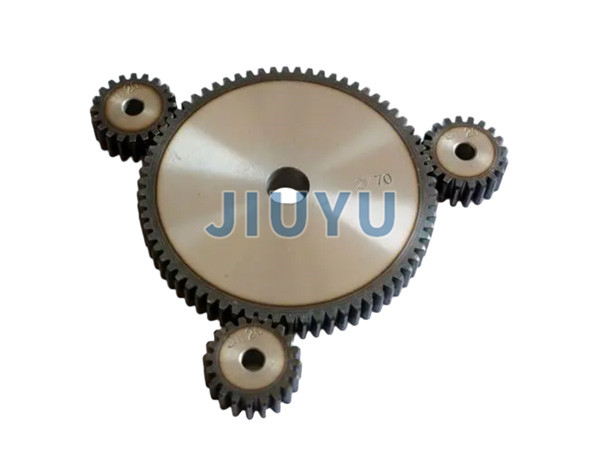
Gear machining is a complex process that typically involves the following main steps:
Gear blank processing
Cutting: Select suitable raw materials based on the size and material requirements of the gear, usually round steel.
. Cut round steel into the required length using cutting equipment and deeply feed it into gear blanks Forging: Forging the billet by applying pressure to cause plastic deformation, with the actual effect being the internal structure of the main material, improving the strength and toughness of the gear. At the same time, forging can also make the shape of the gear closer to the finished product shape, reducing the subsequent machining allowance Heat treatment: The forged gear blank usually needs to undergo heat treatment, such as normalizing or annealing, to eliminate forging stress and improve the cutting performance of the main material Mechanical processing: Turning, milling, and other mechanical processing are performed on the gear blank to produce dimensions such as the outer circle, inner hole, and end face of the gear, preparing for subsequent tooth profile machining Gear profile machining: Hobbing is a commonly used method for gear profile machining. By utilizing the relative motion between the rolling cutter and the gear blank on the gear hobbing machine, the cutting edge of the rolling cutter gradually cuts out the tooth profile on the gear blank. Hobbing can process spur and helical cylindrical gears with high processing efficiency, suitable for mass production Gear hobbing: Using a gear hobbing machine, the gear hobbing cutter performs up and down reciprocating motion and circular feed motion on the gear blank to cut the tooth profile. Gear hobbing is suitable for processing gears such as internal gears and double gears that are difficult to machine with rolling teeth, and the machining accuracy is high, but the production efficiency is relatively low Shaving: For some gears with high precision requirements, shaving technology is usually used for precision machining after hobbing or hobbing. The shaving cutter meshes with the processed gear, and the cutting edge of the shaving cutter performs micro cutting on the tooth surface to correct tooth profile errors and improve tooth surface smoothness and accuracy Grinding teeth: It is a method of tooth profile machining with appropriate precision, used for machining gears with high precision requirements. Grinding the tooth surface with a grinding wheel can eliminate heat treatment deformation, improve tooth profile accuracy and tooth surface quality, and achieve good transmission performance. However, the cost of grinding teeth is high and the processing efficiency is lowHeat Treatment
Quenching: Quenching the processed gear to improve the hardness and performance of the tooth surface, thereby enhancing the load-bearing capacity and service life of the gear.
. The commonly used quenching methods include induction hardening, carburizing hardening, etc. Induction hardening has suitable heating speed and good production efficiency, suitable for medium carbon steel gears; Carburizing and quenching are suitable for low-carbon steel gears, which increase surface hardness and performance while maintaining the toughness of the core by infiltrating carbon atoms into the gear surface Tempering: After quenching, gears need to undergo tempering treatment to eliminate quenching stress, reduce material brittleness, improve gear toughness and comprehensive mechanical propertiesSurface Treatment
Nitriding: A layer of nitride with good hardness and performance is formed on the surface of the gear, which improves the hardness, performance, anti bite and corrosion resistance of the tooth surface.
. The gear after nitriding treatment has minimal deformation and is suitable for some gears that require high precision Hard chromium plating: Coating a layer of hard chromium on the surface of gears can improve the hardness and smoothness of the tooth surface, reduce the friction coefficient, and improve performance stability and corrosiveness. Hard chrome plating is commonly used for gears that operate in harsh environmentsAccuracy Testing and Quality Control
Accuracy Testing: Various measuring instruments and tools, such as gear measuring centers, coordinate measuring instruments, tooth thickness calipers, etc., are used to test the various accuracy indicators of the gear, including tooth profile error, tooth direction error, cumulative error of the pitch, radial runout of the ring gear, etc., to confirm that the accuracy of the gear meets the design requirements.
Quality control: Strictly control the machining process parameters at all stages of gear processing, conduct strict inspection and quality control on raw materials, semi-finished products, and finished products, timely discover and solve problems that arise during the machining process, and protect the stable and excellent quality of gears


